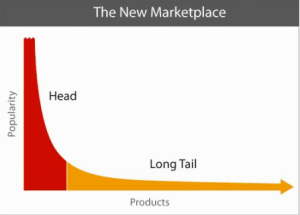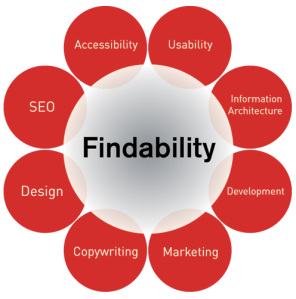The Long Tail is Getting Longer
November 9, 2009 1 Comment

The Long Tail is a concept, first coined by Chris Anderson in a 2004 article in Wired, that talks about how the Internet is changing the media marketplace. Traditionally, markets have been dominated by a few bestselling products – the publishing industry is dominated by a few bestselling authors, the Billboard “Top 40” hits account for the majority of the music sales and “new release” movies account for most of the revenue in a video rental store. Business managers and Economists often use the 80/20 rule or Pareto Principle to describe this heavy concentration of products sells. Basically, the most popular 20% of the products are purchased by 80% or the majority of the consumers.
Why is this so? The answer lies in the economics of supply and demand and the cost of shelf space. An average movie theater will not show a movie unless it can attract at least 1500 people over a two week period. An average record store must sell at least two copies of every CD per year to cover the cost of the shelf space. And so on and so on for videogame stores, movie rental shops, bookstores and newsstands. To pay for the physical display space, a retailer can only afford to stock those products that are guaranteed to sell.
How is the Internet changing this marketplace? By offering consumers choices that can be made available because they do not require shelf space. They are digital. With online retailers such as Amazon, iTunes, Rhapsody, and Netflix, consumers are able to search through millions of titles, far past what is available at the local Blockbuster Video or Barnes and Noble. And the more they find they more they like. These online retailers are discovering that millions of songs, movies and books sold by less popular artists can be profitable. These sales, down the long tail of the Pareto curve, may actually be more profitable, combined, than the sales of popular titles. Thus the phenomenon of the “Long Tail”.
But how is the Tail getting longer? As the Internet markets provide consumers with better search tools, browsing tools and recommendation systems, more products will become visible to the consumers increasing the size of the long tail. Combine that with more sophisticated searching skills by the consumers and you have a long tail reaching to infinity. In a 2006 working paper titled “Goodbye Pareto Principle, Hello Long Tail”, Erik Brynjolfsson, Yu (Jeffrey) Hu, and Duncan Simester found that, “by greatly lowering search costs, information technology in general and Internet markets in particular could substantially increase the collective share of hard-to-find products, thereby creating a longer tail in the distribution of sales” (source: Wiki).
As companies invest in more sophisticated information technologies and consumers become sophisticated information searchers, customers will be able to discover more products than they would have otherwise considered. As the Long Tail phenomenon grows, Brynjolfsson, Hu, and Simester speculate that “the balance of power will continue to shift from a few best-selling products to niche products that are previously difficult to be discovered by consumers. This Long Tail phenomenon will have a profound impact on a firm’s product development strategy, operations strategy, and marketing strategy.” In the future, to be profitable, a company will have to focus on the whole tail.
 The iPhone has changed the landscape of application development. With over 100,000 apps available on the iPhone generating over $1 billion in revenue , it should come as no surprise that Apple’s App Store is big business (source:
The iPhone has changed the landscape of application development. With over 100,000 apps available on the iPhone generating over $1 billion in revenue , it should come as no surprise that Apple’s App Store is big business (source:  How do you select keywords? Find that phrase that pays? With industry knowledge and a deep understanding of the message your web site is conveying, you need to select some generic keywords that describe your site. You can research, validate and augment this list with a keyword tool such as Google’s
How do you select keywords? Find that phrase that pays? With industry knowledge and a deep understanding of the message your web site is conveying, you need to select some generic keywords that describe your site. You can research, validate and augment this list with a keyword tool such as Google’s 